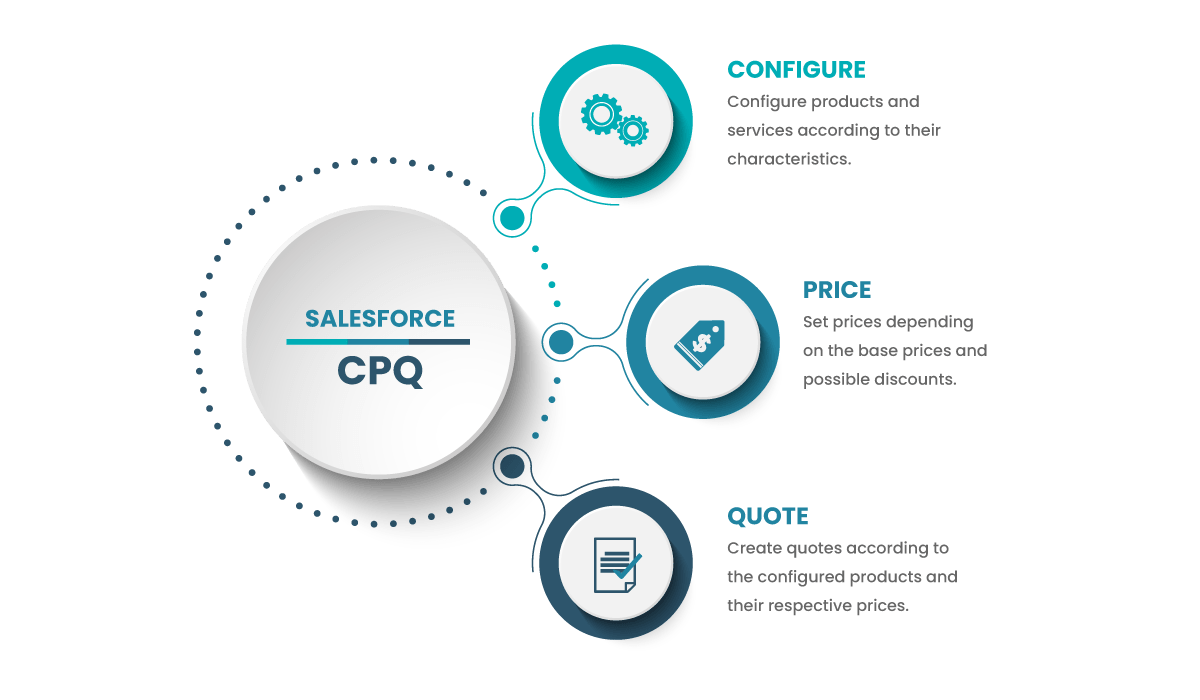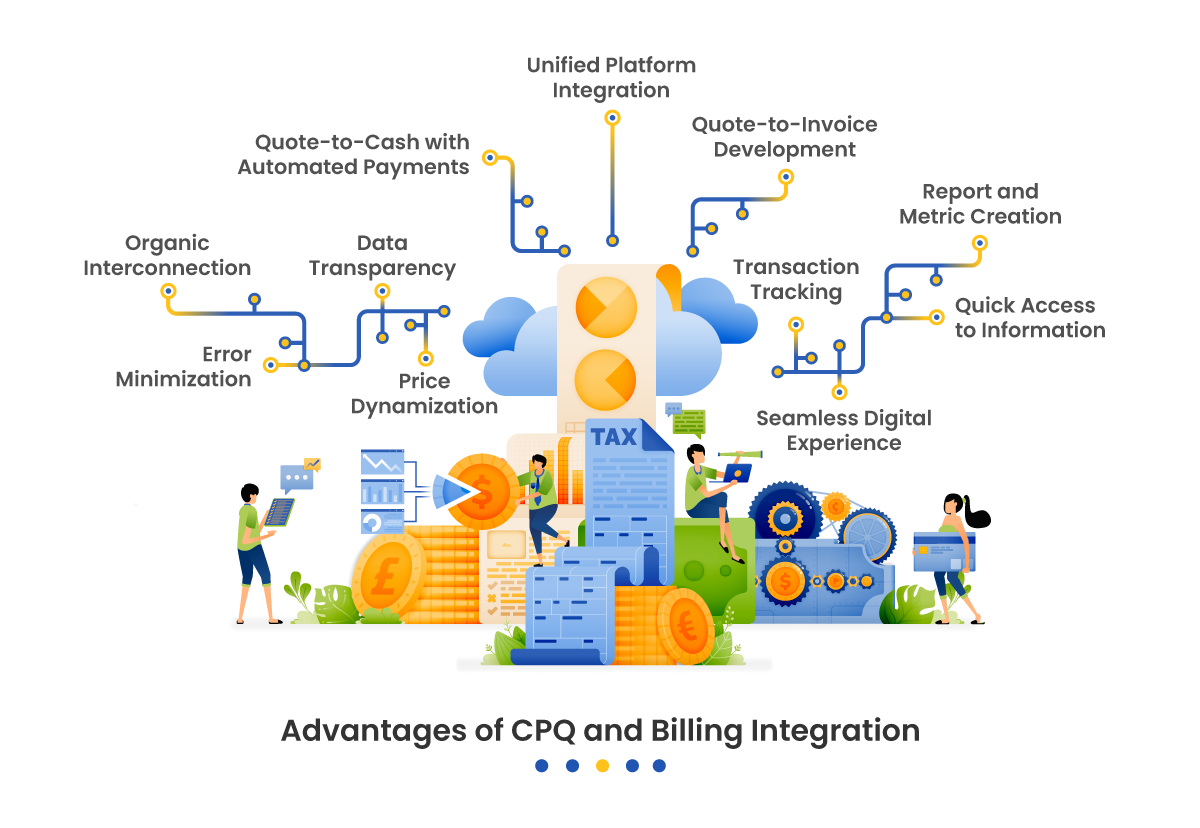Salesforce CPQ is a powerful solution designed to quickly generate accurate quotes for complex products or services. It encompasses crucial phases of the sales cycle, allowing sales reps to make real-time configurations in their product and pricing catalogs. As a result, this sets CPQ implementation as a strategic project in high demand in the market. CPQ tools optimize the overall time spent selling by providing guided selling processes, fast quote-to-cash processes, and reducing quote turnaround time. Put simply, successful CPQ implementation directly influences the company’s efficiency and is reflected in both its commercial processes and the customer purchasing experience.
What is Salesforce CPQ implementation?
Salesforce CPQ implementation refers to the process of integrating this software into the existing systems and workflows within a company. It involves making necessary configurations so that the solution achieves efficient integration with all related business processes. These actions include configuring products and bundles, establishing applicable pricing and discount rules, as well as organizing review and approval processes. All these elements and more require proper configuration to achieve a real impact.
There is no single way to implement Salesforce CPQ. In fact, it can be configured by the company’s IT department, as well as CPQ providers or consultants. This process often has extended timelines due to the need to properly configure the system within the involved business processes. In any scenario, adhering to best practices for Salesforce CPQ implementation is necessary to ensure your company’s transition to a higher level.

Top 10 Benefits of Salesforce CPQ for Your Business
While attempting to solve the most common problems that companies have when generating quotes and closing contracts, Salesforce developed Salesforce CPQ, configuration, price, and quote.
Best practices for Salesforce CPQ implementation
Implementing Salesforce CPQ can be a complex process, especially if we lack experience in this area. However, by carrying it out in an organized manner while guided by best practices, we can ensure proper execution that maximizes the benefits of this powerful tool. Nevertheless, it is always recommended to have a CPQ consultant for greater success assurance on the first attempt. In this regard, we provide you with a series of tips that you can consider as best practices when implementing Salesforce CPQ.
1- Plan the implementation process.
When deciding to implement Salesforce CPQ, you must carry out detailed planning based on what you wish to achieve. To this point, you need to define the objectives that drove you to take this step as it cannot be a matter of trend or mere enthusiasm. For example, you may set a goal to reduce the time allocated to sales or increase the average order value per customer, among others. So, carefully analyze your company’s business needs, the scope you desire for the project, the time it will require, costs and risks, as well as the resources, both human and technical, you will need.
Remember that the set objectives must be measurable. This will allow you to later verify, with concrete data, the impact of this implementation and the return on investment made. Once all these elements are defined, establish a realistic schedule that leads to successful execution. Furthermore, do not forget to communicate the plan to all those involved in the process, both developers and end users. All stakeholders need to know the what, how, and when of the process, especially those who will be most impacted by the changes, which is often the sales team members.
2- Understand your company’s current processes.
Before implementing Salesforce CPQ, you must understand your company’s business operations. This involves all aspects related to your sales process, from quoting to revenue collection. Also, understand how it integrates with the sales, operations, and finance departments. To do this, you will need to conduct an assessment to identify areas and aspects that require improvement.
In fact, the implementation of Salesforce CPQ itself involves a review and analysis of all these processes to determine how they can be optimized to meet the company’s needs. Once identified, the Salesforce CPQ solution can step in to address deficiencies while enhancing well-functioning tasks.
3- Configure basic functions, then customize.
Every system has primary functionalities that are easy to configure and ensure the basic operation of the process they respond to, so we start with those that are essential! In this case, they could be related to product configuration, pricing, and rules. Once that’s done, you can configure more advanced functionalities that better suit the specific characteristics of your company, based on the goals to be achieved and the current state of the system.
Salesforce CPQ has many diverse functions, so configuring all of them at once can be quite cumbersome. Remember that optimization lies in simplicity, so whenever possible, try to find the right balance between simplicity and customization.

4- Train users and encourage active stakeholder participation.
Provide adequate training to system users so they can effectively use and make the most of its functionalities. Conduct tailored training sessions for different roles and departments in your company to guide employees in adopting a new way of managing their usual tasks. This may include online training, in-person sessions, as well as the provision of reference materials and step-by-step guides. Also, actively involve key stakeholders at all stages of Salesforce CPQ implementation to ensure that previously reconciled and accepted requirements are covered. This may include sales, operations, finance, and IT teams, among others.
5- Integrate Salesforce CPQ with other systems.
If you want to ensure smooth and consistent operation throughout the company, you need to ensure proper integration of Salesforce CPQ with all the other systems your company works with. For example, Salesforce CPQ should integrate efficiently with the entire CRM ecosystem, especially with Salesforce Billing, ERP, accounting software, etc. This guarantees that all data generated regarding your company’s prices and quotes are accurate while positively impacting its efficiency.
At SkyPlanner LLC, we successfully implemented CPQ for our client ALS, facilitating the effective replacement of DealHub. This not only improved their quotes, but also provided them with greater customization in their offers, advanced automation in proposal generation, and smoother integration with their CRM.

6- Ensure data management.
For your company’s sales team to conduct an adequate quoting process for a client, they need to have all the data that your company has captured about said client. This data may be scattered across various systems, making it challenging to achieve a comprehensive view. Therefore, an important action in the Salesforce CPQ implementation process is organizing the data and ensuring that it is all in one place in a suitable and understandable format more geared towards the solution. Data management is an essential component of CPQ and helps distinguish it from other systems with similar functionalities. With proper data management, CPQ can boost accuracy in quotes, positively impacting the company’s efficiency.
7- Monitor progress and conduct systematic evaluations.
As the implementation process progresses, it is recommended to monitor its progress to promptly detect difficulties or areas for improvement. Every time new configurations are made; you should proceed to evaluate if what you have introduced is working well. Conduct comprehensive testing of all Salesforce CPQ functionalities to ensure they function as expected,effectively align with your business processes, and rely on KPIs for a more precise assessment. To this end, we recommend the following:
- Percentage of quotes created via CPQ. It should be over 90%.
- Percentage of quotes disputed due to errors. Before using CPQ, an estimated 30% of them have at least one error.
- Customer response time. You may see reductions close to 80%.
Evaluate all configured components, as well as the effectiveness of CPQ integration with other systems. Additionally, conduct tests with some end users to check if it meets their expectations and gather feedback based on their experience. Also, don’t forget to conduct security and overall performance evaluations under different demands and circumstances. Furthermore, after the initial implementation, consider making continuous iterations to optimize quoting processes based on user feedback and changes in the business. Maintain an agile and adaptable approach to the changing needs of your company.
In summary, Salesforce CPQ implementation is a complex process that requires valuable technical and human resources. If you are considering implementing Salesforce CPQ in your company and need guidance, the SkyPlanner team can provide you with the guidance and support you need from start to finish. You can contact us at hello@theskyplanner.com.



